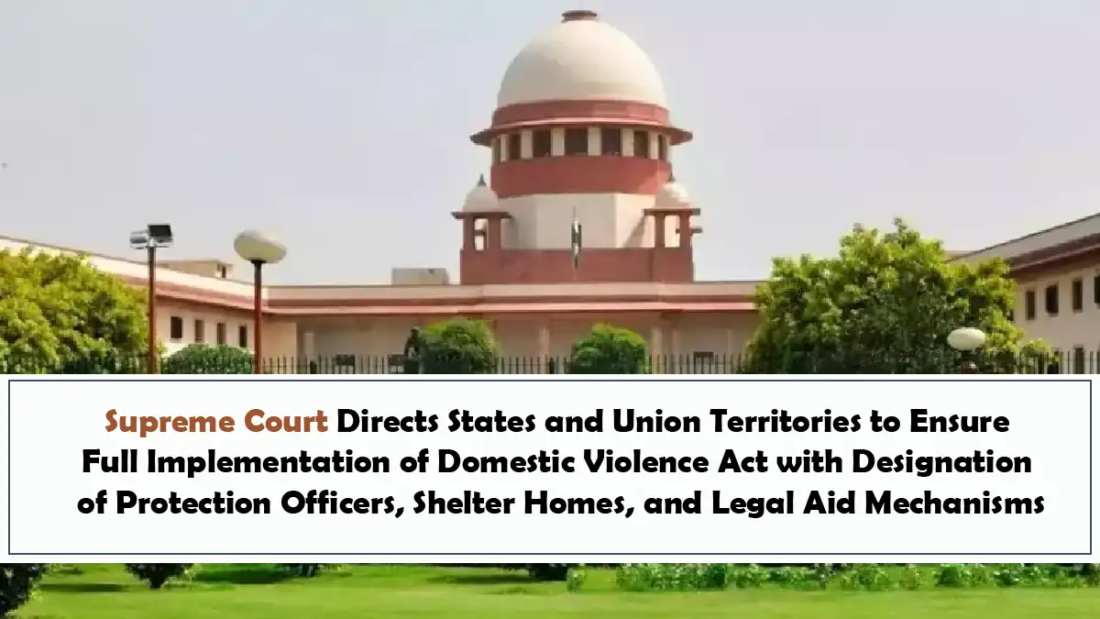Facts of the Case
The Supreme Court was hearing a writ petition filed by the NGO We the Women of India, seeking effective implementation of the Protection of Women from Domestic Violence Act, 2005 (PWDVA). The petition emphasized long-standing non-compliance with key provisions of the Act, including failure to appoint Protection Officers, lack of legal aid and shelter homes, and inadequate public awareness about the law’s remedies.
The bench, comprising Justice B.V. Nagarathna and Justice S.C. Sharma, acknowledged the legislative intent of the PWDVA, which was enacted to ensure protection for women victims of domestic violence in accordance with Article 15(3) of the Constitution of India.
Contention of the Petitioner
The petitioner submitted that despite several prior directions by the Court, crucial components of the PWDVA remain poorly implemented across many States and Union Territories:
- Appointment of Protection Officers under Section 8 is either incomplete or done perfunctorily by assigning unrelated staff, such as ICDS or Anganwadi workers.
- Empanelment of service providers under Section 10 remains neglected in many regions, hampering support for victims.
- Shelter homes mandated under Section 6 are unavailable or inaccessible in several districts.
- Legal aid and advice, as required by Section 9(d) of PWDVA read with Section 12 of the Legal Services Authorities Act, 1987, are not being made available to aggrieved women.
- Wide publicity of the Act under Section 11 is lacking, leaving women unaware of their rights and available remedies.
The petitioner requested urgent judicial directions to remedy these lapses.
Contention of the Respondents
The State Governments and the Union of India, through their standing counsel, acknowledged the implementation gaps and expressed willingness to comply with Court directions. They requested a reasonable time frame to coordinate with their respective Departments of Women and Child Development and Legal Services Authorities.
Counsel for NALSA also assured that they would take necessary steps to facilitate legal aid for victims of domestic violence, as mandated by law.
Court’s Observations
The Supreme Court delivered a strongly worded order reinforcing the constitutional and statutory obligations of the State and Central Governments under the PWDVA.
“The Protection of Women from Domestic Violence Act, 2005… is an Act to provide for more effective protection of the rights of women guaranteed under the Constitution of India to those who are victims of violence of any kind occurring within the family…”
“Dedicated Protection Officers have to be appointed by the States/Union Territories… the casting of responsibilities on Anganwadi workers would not be of much assistance.”
The Court noted that the failure to implement even the basic components of the Act, after nearly two decades of its enactment, is deeply concerning and deprives victims of meaningful access to justice.
It emphasized that designating Protection Officers, empanelling service providers, ensuring shelter homes, and publicizing legal rights are all statutory mandates not administrative options.
Court’s Order
The Supreme Court issued the following mandatory directions:
- Appointment of Protection Officers:
All States and Union Territories must identify and designate officers from the Department of Women and Child Development at district and taluka levels as Protection Officers under Section 8 of the Act. This must be completed within 6 weeks where not already done.
- Coordination by Chief Secretaries:
Chief Secretaries and Department Secretaries of Women and Child Development shall ensure full compliance and coordination. - Publicity of Legal Provisions:
Under Section 11, wide publicity must be given to the provisions of the Act via public media to promote awareness and ensure inter-ministerial coordination.
- Direction to the Central Government:
The Union of India must also take adequate steps to discharge its duties under Section 11.
- Free Legal Aid to Distressed Women:
NALSA is directed to instruct Legal Services Authorities at all levels (State, District, Taluka) that all aggrieved women under the Act are entitled to free legal aid. “It goes without saying that should any distressed woman approach the Member Secretary… the same would be provided expeditiously.”
- Public Awareness of Legal Aid:
Legal Services Authorities at all levels must publicize the entitlement to free legal aid for women under the Act.
- Service Providers and Shelter Homes:
All States and UTs must:
- Empanel service providers under Section 10
- Identify and notify shelter homes (Nari Niketan, one-stop centers, etc.) within 10 weeks at the district and taluka level.
SC stated that “Steps have to be taken to ensure that such homes are made available to the distressed women.”
The Court noted that these were only initial steps and reserved the right to issue further directions to ensure full implementation of the law.
Credits: Adv. Deeksha Rai
 Cart is empty
Cart is empty 

